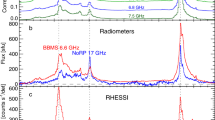Abstract
Faintly visible, darkened regions in Hα lying outside but adjacentto bright flare emissionwere found to occur in 10 of 31 major flares investigated. Without exception, the darkenings occur over ‘magnetically neutral’ areas, and these are usually bordered by ridges ofoppositely-poled field, where one border is shared in common with a flare ribbon. Thedarkenings probably result from the formation of faint, outlying loop systems, similar topost-flare loops seen in absorption, but which are connected to magnetic features outsidethe flare and are unresolved or only marginally resolved in patrol images. Simple modelsfor post-flare loops incorporating the results of statistical equilibrium calculations readilydemonstrate that darkenings of several percent (consistent with our photometric measurements) can be produced by loop structures of cross-sectional diameter ≈ 102 km (unresolved by patrol instruments) and containing gas at densities 5 × 1010–5 × 1011 cm-3 andtemperatures 8000–15000 K. Outlying loop systems might be formed by magnetic fieldreconnection, analogous to the mechanism ascribed to eruptive two-ribbon flares, butassociated with field structures adjacent to the flare. Alternatively, these outlying loopsystems may not erupt but become visible as a result of heating and chromospheric evaporation at the footpoints shared with the flare ribbon. In either case, the observations presented here have interesting implications for both the spatial scale and the topology of thecoronal magnetic fields in which eruptions occur.
Similar content being viewed by others
References
Crooker, N. U., Siscoe, G. L., Schodhan, S., Webb, D. F., Gosling, J. T. and Smith, E. J.: 1993, J. Geophys. Res. 98, 9371.
Ellison, M. A., McKenna, S. M. P., and Reid, J. H.:1960, Observatory 80, 149.
Ellison, M. A., McKenna, S. M. P., and Reid, J. H.: 1961,Monthly Notices Roy. Astron. Soc. 122,491.
Foing, B. H., Bonnet, R. M., Dame, L., Bruner, M., Acton, L. W., andBrown, W. A.: 1986, in D. Neidig (ed.), The Lower Atmosphere of Solar Flares, Conference Proceedings,National Solar Observatory, p. 319.
Heinzel, P. and Karlický, M.: 1987, Solar Phys. 110, 343.
Kahler, S. W., Sheeley, N. R., and Liggett, M.: 1989, Astrophys. J. 344,1026.
Newkirk, G. A.: 1967, Ann. Rev. Astron. Astophys. 5, 213.
Švestka, Z.: 1965, Adv. Astron. Astrophys. 3, 119.
Švestka, Z. F., Fontenla, J. M., Machado, M. E., Martin, S. F., Neidig, D. F., and Poletto, G.: 1987, Solar Phys. 108, 237.
Tandberg-Hanssen, E.: 1974, Solar Prominences, D. Reidel Publ. Co., Dordrecht, Holland.
Tsunet, S., Acton, L., Bruner, M., Lemen, J., Brown, W., Caravalho, R., Catura, R., Freeland, S., Jurcevich, B., Morrison, M., Ogawara, Y., Hirayama, T., and Owens, J.: 1991, Solar Phys. 136, 37.
Vernazza, J. E., Avrett, E. H., and Loeser, R.: 1981 Astrophys. J. Suppl. Ser. 45, 635.
Webb, D. F., Kahler, S. W., McIntosh, P. S., and Klimchuk, J. A.: 1996, J. Geophys. Res. submitted.
Author information
Authors and Affiliations
Rights and permissions
About this article
Cite this article
Neidig, D.F., Švestka, Z., Cliver, E.W. et al. OBSERVATIONS OF FAINT, OUTLYING LOOP SYSTEMS IN LARGE FLARES. Solar Physics 170, 321–339 (1997). https://doi.org/10.1023/A:1004923212539
Issue Date:
DOI: https://doi.org/10.1023/A:1004923212539



